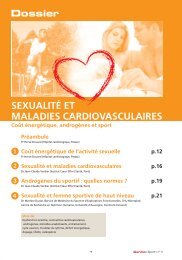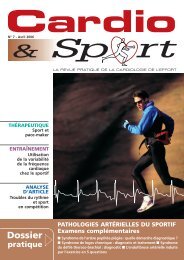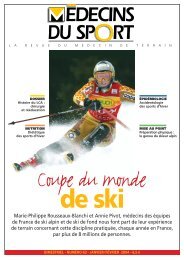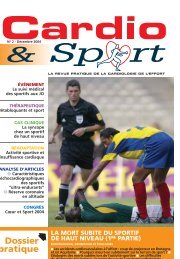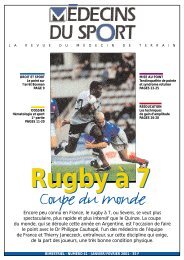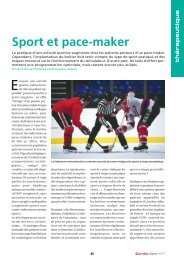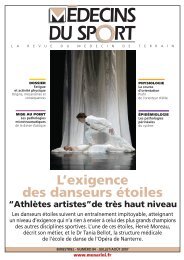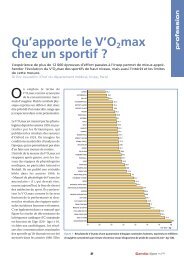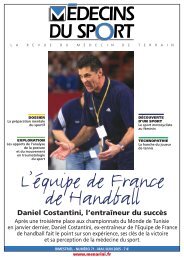Cardio et Sport - msport.net
Cardio et Sport - msport.net
Cardio et Sport - msport.net
- No tags were found...
You also want an ePaper? Increase the reach of your titles
YUMPU automatically turns print PDFs into web optimized ePapers that Google loves.
Le point sur...Elargissementde l'onde P(D2, VF, V2-3)chez un sportifprofessionnelde 32 ans.ischémie au niveau de la microcirculation.Si le bilan cardiovasculaireexhaustif est normal, la pratique sportivesous surveillance annuelle peutêtre autorisée.> En conclusionLes particularités de la conduction ducœur d’athlète ne doivent être nisous-estimées, ni surestimées. Ellesne se conçoivent que chez des suj<strong>et</strong>sasymptomatiques. Elles ne s’observentqu’en cas de haut niveau d’entraînement<strong>et</strong> plus souvent chez lesendurants. Leur découverte chez unefemme doit un peu plus alerter. L’analyse<strong>et</strong> la comparaison d’ECG successifssont le gage de l’utilité de c<strong>et</strong>examen basique de dépistage. ❚“naturellement” le voltage des QRS <strong>et</strong>rendant donc les critères de Cornell <strong>et</strong>Sokolow moins sensibles. Il est associéà une hypertrophie ventriculaire droite.Il peut, parfois, poser, dans c<strong>et</strong>te population,des problèmes diagnostiques avecla dysplasie ventriculaire droite arythmogène<strong>et</strong> le syndrome de Brugada.Bloc compl<strong>et</strong> gaucheExceptionnel au repos, il doit fairerechercher systématiquement unecardiopathie qui, dans 70 % des cas,sera une coronaropathie.Déviations axialesObservées dans 5 % des cas <strong>et</strong> plussouvent chez les hommes <strong>et</strong> les sportifsvétérans, les déviations axialesgauche (≥ - 30°) ou droite (> 110°), nefont pas partie des signes ECG ducœur d’athlète <strong>et</strong> doivent conduire àun bilan approfondi.Troubles de conductionpariétaux à l'effortIls sont toujours évocateurs de pathologiecardiaque, notamment coronarienne.Le bloc gauche d’effort peut êtredouloureux lors de son installation,même sans lésion coronaire significative.Son incidence est de0,17 à 0,5 % des épreuves d'effort toutvenant (10 000 BBG d'effort annuelsaux USA !), y compris chez le sportif.Des anomalies associées à la scintigraphiefont parfois évoquer uneBibliographie1. Pelliccia A, Maron BJ, Di Paolo FM <strong>et</strong> al.Prevalence and clinical significance ofleft atrial remodelling in comp<strong>et</strong>itive athl<strong>et</strong>es.J Am Coll <strong>Cardio</strong>l 2005 ; 46 : 690-6.2. Schuchert A, Wagner SM, Frost G,Meinertz T. Moderate exercise inducesdifferent autonomic modulations of sinusand AV node. Pacing Clin Electrophysiol2005 ; 28 : 196-9.3. Pelliccia A, Maron BJ, Culasso F <strong>et</strong> al.Clinical significance of abnormal electrocardiographicpatterns in trainedathl<strong>et</strong>es. Circulation 2000 ; 102 : 278-84.4. Fuller CM, McNulty CM, Spring DA <strong>et</strong>al. Prospective screeninig of 5,615 highschool athl<strong>et</strong>es for risk of sudden cardiacdeath. Med Sci <strong>Sport</strong>s Exerc 1997 ; 29 :1131-8.5. Scott AS, Eberhard A, Ofir D <strong>et</strong> al.Enhanced cardiac vagal efferent activitydoes not explain training-induced bradycardia.Auton Neurosci 2004 ; 112 : 60-8.6. Sharma S, Whyte G, Elliott P <strong>et</strong> al.MOTS CLÉSBloc atrio-ventriculaire,Bloc incompl<strong>et</strong>, Bloc compl<strong>et</strong>,Déviation axiale,Pauses cardiaques,<strong>Sport</strong>if, Trouble intra-atrialElectrocardiographic changes in 1 000highly trained junior elite athl<strong>et</strong>es. Br J<strong>Sport</strong>s Med 1999 ; 33 : 319-24.7. Langdeau JB, Blier L, Turcotte H <strong>et</strong> al.Electrocardiographic findings in athl<strong>et</strong>es:the prevalence of left ventricular hypertrophyand conduction defects. Can J<strong>Cardio</strong>l 2001 ; 17 : 655-9.8. Stein R, Medeiros CM, Rosito GA <strong>et</strong> al.Intrinsic sinus and atrioventricular nodeelectrophysiologic adaptations in enduranceathl<strong>et</strong>es. J Am Coll <strong>Cardio</strong>l 2002 ;39 : 1033-8.9. Hood S, Northcote RJ. Cardiac assessmentof v<strong>et</strong>eran endurance athl<strong>et</strong>es: a12 year follow up study. Br J <strong>Sport</strong>s Med1999 ; 33 : 239-43.10. Chan PG, Logue M, Kliegfield P. Effectof right bundle branch block on electrocardiographicamplitudes, including combinedvoltage criteria used for thed<strong>et</strong>ection of left ventricular hypertrophy.Ann Noninvasive Electrocardiol 2006 ; 11 :230-6.<strong>Cardio</strong>&<strong>Sport</strong> • n°14 32




